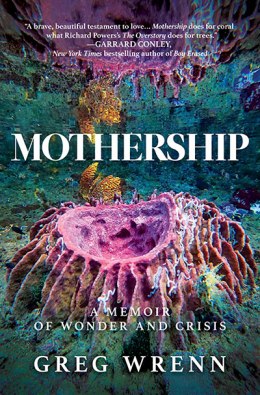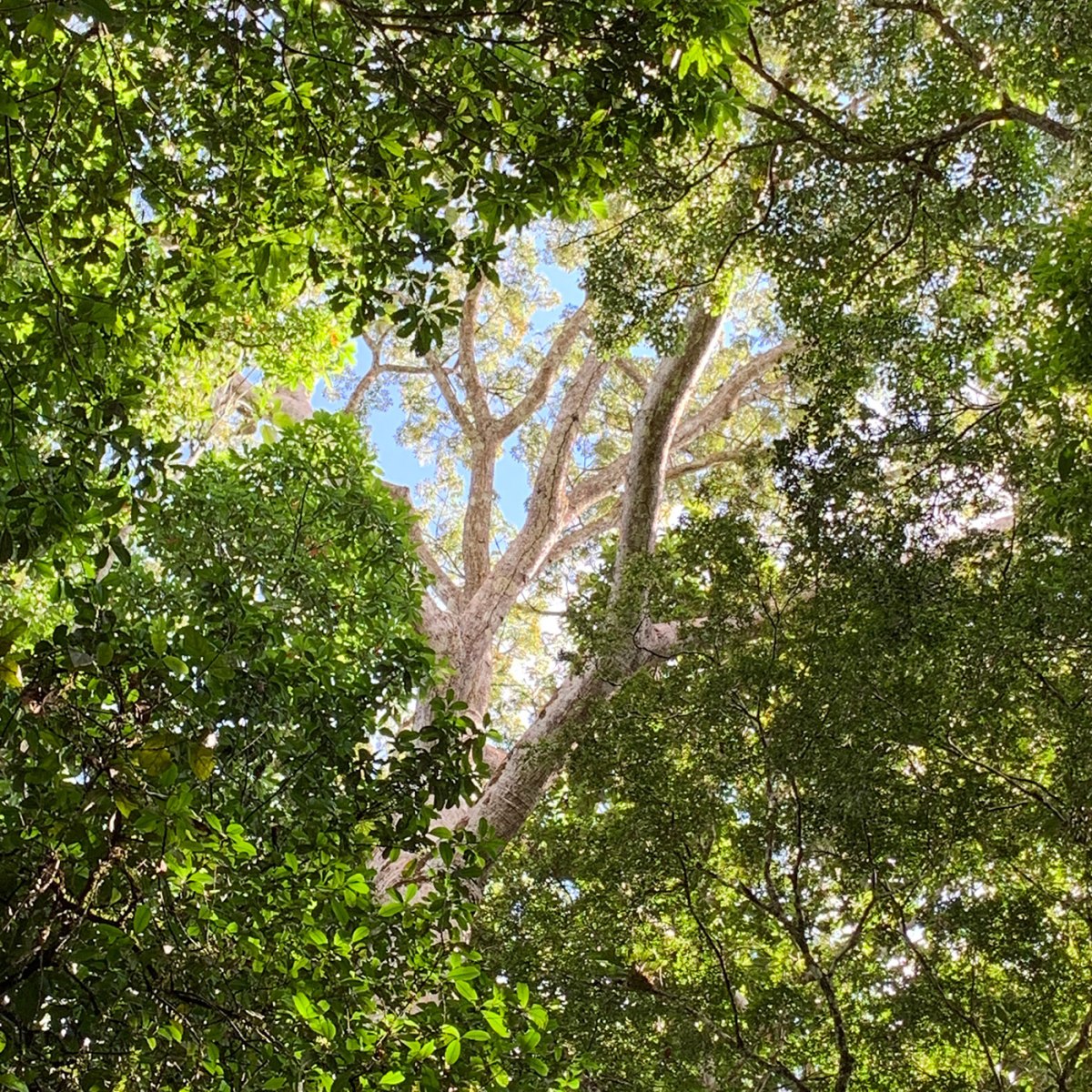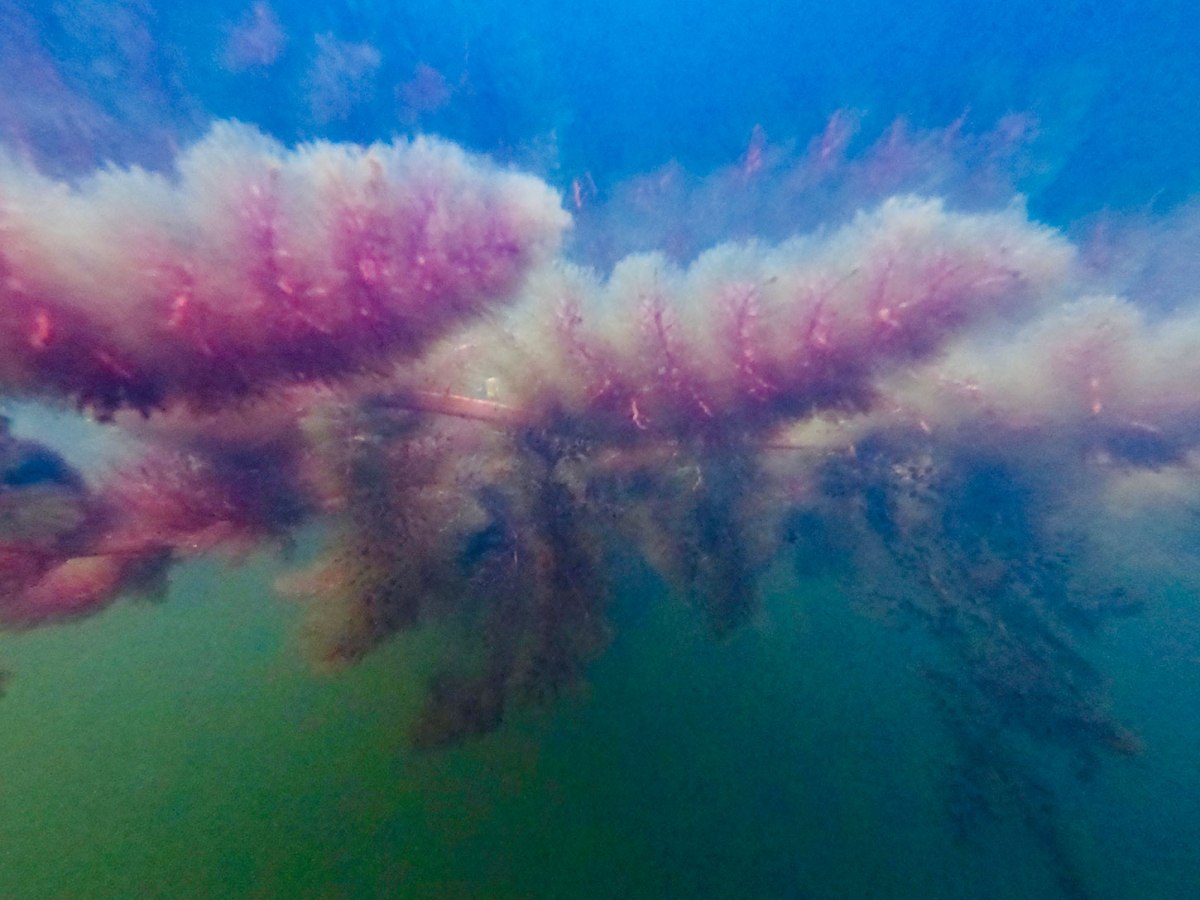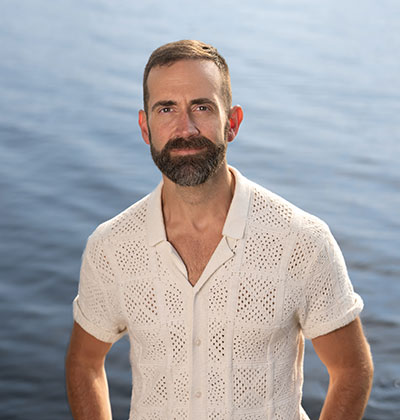At Tahuayo, with critical periods reopened, the first lessons of Madre Ayahuasca were instilled in my brain.
Overjoyed after after my first life-saving ayahuasca ceremonies at Dreamglade, I traveled by boat six hours south to the Amazon Research Center in the Tamshiyacu Tahuayo Regional Conservation Area. Larger than Rhode Island, it’s one of the most biodiverse sections of the staggeringly diverse Amazon. Manatees, pink and gray dolphins, and giant otters swim in the rivers. I would end up spotting pygmy marmosets, capuchin monkeys, saki monkeys, spider monkeys, and mustached tamarins—more primate species live here than in any other protected area in the world. Despite my last name, I’m not much of a birder, but the churring blue-crowned trogons did astound me. I didn’t come here for the animals, though.

Drawing on 70 peer-reviewed articles, Mothership: A Memoir of Wonder and Crisis is a queer coming-of-age story that explores Greg Wrenn’s quest to save his life by turning to endangered coral reefs and ayahuasca, waking up his ecological conscience along the way.
“Bodacious,” I murmured as I looked up.
“This is a lupuna,” my stocky guide Manuel said as he paddled us toward the gigantic tree coming out of the water. Some distance from it, he tied the canoe to some branches poking out of the water. It was the wet season. The rainforest was flooded with six feet of the swollen Tahuayo River, a 50 mile-long tributary of the Amazon.
“¡Qué gigante!” I exclaimed. Manuel didn’t know how tall this lupuna was—measuring it would require special equipment—but the species, the tallest in the Amazon, can reach 240 feet; its crown can stretch out 200 feet; and the oldest approach a millennium in age. With exposed buttress roots resembling rocket fins, it felt like it might lift off any minute.
The branches were dripping with bromeliads and orchids. On the bark were bumps, thorns, and camo-colored lichen. Fish that Manuel called sardines puckered the water. My long legs hanging over the bow, I lay back in the canoe, a life jacket as my pillow. Manuel dozed off, and I set my phone timer for one hour.
By now, having taken me to meditate underneath some of the largest, oldest trees in Tahuayo—giants of the forest like the quinilla, paranari, ojé, and machimango—Manuel was more comfortable around me. When I told him I’d just left an ayahuasca retreat, he looked at me a bit suspiciously—too many foreign “medicine men” have caused big problems in local communities in Peru, like the Canadian guy the year before who murdered the Shipibo’s spiritual mother, then was lynched afterwards by villagers. And as Manuel was quick to point out, some shamans, Peruvian and gringo, have bad intentions. In Peru, brujería—black magic—is not woo-woo. It’s considered by many people to be a real danger.
But I knew why I was here. Given how malleable the brain is after psychedelics, this was a precious window of time I wasn’t going to waste.

Photo by Greg Wrenn.
A few years later, I learned just how special the psychedelic afterglow is from the work of Johns Hopkins researcher Gül Dölen. Giving MDMA (“molly”) to octopuses and rats led her to an astounding finding: psychedelics reopen the critical period for social reward learning. Marked by heightened neuroplasticity, a critical period is when certain experiences are needed by a child for normal development to occur. If the child doesn’t receive the right “inputs” during that window of time, it may have long-lasting effects on development. Think of a five-year-old on TikTok for hours most days instead of bonding with family and friends, or a male zebra finch exposed to rock music instead of an elder’s birdsong. If the bird hasn’t learned to sing by day 65 after hatching, he never will.
Maybe give that finch a thimbleful of aya? A psychedelic experience, Dölen theorizes, is the experience of critical periods reopening—this, I think, partly explains ayahuasca’s re-mothering of me at Dreamglade and why Amazonian cultures call the brew a teacher. Echoing Robin Carhart-Harris’s research on the childlike brains of tripping adults, ayahuasca primes us for new learning, especially around social rewards. Happiness requires connection, so if you don’t know how to connect with yourself and others, you’ve been set up for misery.
At Tahuayo, with critical periods reopened, the first lessons of Madre Ayahuasca were instilled in my brain. I practiced relating with myself more cheerfully and rationally. Research, I’ve already said, indicates ayahuasca strengthens mindfulness. And mindfulness diminishes addictive cravings, boosts impulse control, and promotes neuroplasticity. Just as I had done underwater in Raja Ampat, it seemed like a good time to meditate intensively in nature, away from screens that could reinforce behaviors I was trying to end. As motivation, I remembered the two most inspiring words in the English language, ones Rick Hanson taught me. Neurogenesis: new neurons being born in the brain. Neuroplasticity: neurons growing new branches and pruning others, some of the 125 trillion synapses in the brain switching off and others switching on.
[embedded content]
As I meditated on my back in the canoe, my propped-up legs were spread apart, my most vulnerable parts facing the lupuna. With every exhale, my body sank further into the canoe, briefly reactivating the ayahuasca. In my mind’s eye, I grew lupuna roots. Became the tree’s twin. With no up or down, we were floating in outer space, our roots almost touching, like two neurons forming a synapse. My brain was replaced with a lupuna’s crown. I felt as tall as the tree, and as patient and strong. Lupunas survive, no, thrive as they’re inundated by seasonal floods.
I’d stepped into a universal archetype, the Tree of Life. My brownish-white fruit isn’t forbidden, it seemed to say. Chill out, won’t you?
As my mindfulness deepened, the late afternoon sun, suddenly breaking through the canopy, shone into my brain. I had no skull or skin. Looking up at a triangle of sky shaped like a manta’s wing, I kept silently saying, I praise you, I love you, whatever you are.
In Pilgrim at Tinker Creek, Annie Dillard famously sees “the tree with the lights in it.” For a half second, the lupuna and I flickered like that, spitting like a pair of pilot lights in a draft. “It was less like seeing than like being for the first time seen,” she writes, “knocked breathless by a powerful glance.” As at Dreamglade, flashbacks sped through me so fast I could barely see glimpses of the circus animals on my nursery wallpaper. But I stayed calm and centered, guarded by this tree and the research binder in my backpack.
I had made myself Dr. Inserra’s guinea pig: Repressed memories were surfacing. Fear was being driven out of them. The memories couldn’t be erased, but as they reconsolidated, I trusted they were incorporating memories of this tree. I had faith I’d be able to tolerate them whenever they resurfaced. They’d be less frightening then. With less fear, there’s less need to medicate and it’s easier to connect with others.
“Macho!” I heard Raul say, making me smile. “Macho!”
As I meditated and H.E.A.L.-ed under the lupuna, I was, unwittingly, forest bathing. Shinrin-yoku, the Japanese call it. Since the 1980s, Japanese doctors had been prescribing slow, unplugged walks in nature to their stressed-out urban patients. In a wide variety of studies, forest bathing has been shown to lower blood pressure, reduce the stress hormone cortisol, diminish psychological stress, and boost mood. A godsend for those of us on constant red alert. Even when we’re indoors, vegetation boosts wellbeing. One famous study found that hospital patients recovering from gallbladder surgery healed more quickly and needed fewer pain meds when greenery rather than a brick wall was visible out the window.
These studies confirm common sense: spending time outdoors makes us feel better. Perhaps this is one reason Konstan’s father Leo was willing to die trying to protect his rainforests in Raja Ampat from illegal loggers. I knew I was happier living in Virginia where I could get in my car and be hiking in 20 minutes. The traffic, difficult parking, and crowded trails kept me from doing this in California.
In the Amazon, instead of being forcibly bathed in Jacksonville’s tap water—or immersing myself in the clear water mangroves of Raja Ampat or being consensually bathed by Raul and Lidia’s icaros during ayahuasca limpiezas—I was bathing in forest air. Bathing in rainforest air, that is, as a rainforest medicine was still in my system. But there were other medicines of sorts I was inhaling that scientists say could be behind shinrin-yoku’s effectiveness:
- Phytoncides, which are antimicrobial essential oils released by trees that scientists believe are responsible for positive psychological effects.
- Negative air ions, which have been most conclusively linked to lower depression scores. (These particles are found in higher concentrations near forests and bodies of water like rivers, waterfalls, and the ocean.)
- Bacteria, which can find their way into the gut. A healthy, diverse microbiome has been linked to better mental and physical health.
The more biodiverse a forest is, the wider the array of phytoncides and bacteria, and as research is beginning to indicate, the greater the psychological boost. In Amazonian wetland forests like the one in Tahuayo, there are 3,688 recorded tree species. In the entire Amazon, there are an estimated 16,000 species; in Shenandoah National Park, there are only 331; in the woods of my neighborhood in Florida, I’d guess a couple dozen. It stands to reason that, given Tahuayo’s tree density and diversity, this might be one of the best places on earth to forest bathe. (I should add that breathing clean air rich with microbes, as we did to varying degrees for thousands of years, should be a birthright. Biodiversity must be protected. Access to wilderness can’t only be for the privileged, affluent, adventurous, able-bodied, and lucky.)
In the canoe, by simply breathing, the rainforest was medicating me with dozens of different phytoncides. With tiny flecks of lichen from the lupuna. Pollen from the orchids a hundred feet above. Capuchin monkey dander. Bacteria that only live in the buttholes of giant river otters and in the blowholes of pink dolphins. Helicopter dragonfly scat, mites falling from slate-colored hawks, and bits of bark from the hundreds of tree species within an acre of us. With thousands of different types of fungal spores.
All this was raining down on me, clinging to my nasal passages and throat, some of it bypassing the blood brain barrier altogether and entering my brain. (This is why air pollution is so dangerous.) Some of this would make it down my esophagus, eventually enriching my gut bacteria, which produce 95 percent of the body’s mood-regulating serotonin. A 2015 study in Science Advances showed that uncontacted tribes in the Amazon had the greatest diversity in gut bacteria ever recorded, Americans among the lowest.
Might this be one definition of great modern mothering, to dirty your children? The bottle formula I drank as a baby instead of breast milk, my mother’s constant use of wet wipes, the antibiotics samples my Big Pharma rep father slipped us for our chronic ear and sinus infections, the Pringles, Cheerios, and canned waxed beans we ate—according to what’s known as the hygiene hypothesis, all these well-intentioned aspects of my upbringing may have undermined my family’s microbiome, making us more susceptible to mental and physical illness. Within a decade or two, as the climate and mental health crises worsen and the brain-gut connection is researched further, microbiome-enhancing poop transplants—and ayahuasca, for that matter—will likely go mainstream.

Photo by Greg Wrenn.
“Okay if I jump in the river?” I asked Manuel after the timer rang. Scarlet macaws squawked in the distance. Cicadas and katydids fiddled. Manuel blew a snot rocket.
“Yeah, man, take care with the branches and thorns.”
My mind raced with the aquatic dangers I read about—freshwater stingrays, electric eels, the fish that swims up your urethra. Bull sharks, I recalled, can be found 2,500 miles up the Amazon.
“If a black caiman bothers you,” he said, referring to the alligator-like reptile, the largest predator in the Amazon, “I’ll jump in and break its neck.”
“What about piranhas?”
“The people eaters aren’t here. You’re fine, you’re fine—go and trust me, man.”
Wearing only Wellington boots, my underwear, and my mask and snorkel, I should’ve been at an amphibious Radical Faerie gathering. I slid from the canoe into the water.
I could stand up. The water was up to my chest.
“Eek!” I cried out. “Something nipped my leg!”
“It’s little fishes. Curious about you.”
I put my head under. Sardines were schooling about. The visibility was at best a foot, like diluted coffee.
What was that splashing in the distance? I’d seen the trailer to Anaconda.
I looked back at Manuel, who was dozing off. I was scared, but I snorkeled anyway toward the giant lupuna until I was right underneath it holding onto the submerged buttress roots. Recalling Drew’s story about the golden statue, I stood on the muddy bottom and looked up the trunk toward the massive crown. My lower back pain was gone. My boots were firmly planted. Humbled by the lupuna’s power, I was standing in my own.
When Manuel wasn’t looking, I lifted my hands like the exultant underwater statue in the Florida Keys and the branches of dying elkhorn coral near it. Though I felt as tall and rooted as the lupuna, I also felt small. Even so, it wasn’t the smallness of C-PTSD. It was awe-induced insignificance. I was no one’s puppet, no one’s whore.
I didn’t realize it at the time, but snorkeling in a flooded rainforest, I was swallowing minute amounts of the river’s microbiome in my snorkel, just as the microbiome of Raja Ampat’s astoundingly biodiverse reefs had found its way into my body.
Bacteria and repressed memories are invisible. So was the methane, king of greenhouse gases, rising in the Amazon from the plant matter rotting underwater.
What I couldn’t see was as important as what I could.
 A former Stegner Fellow at Stanford University, Greg Wrenn is the author of the queer ayahuasca eco-memoir Mothership and Centaur, which was awarded the Brittingham Prize in Poetry. His work has appeared in The New Republic, The Daily Beast, Al Jazeera, The Rumpus, and elsewhere. As an associate English professor at James Madison University, he weaves climate change science into literary studies. A student of ayahuasca since 2019, he and his husband live in Virginia on the ancestral homelands of the Manahoac and Monacan people.
A former Stegner Fellow at Stanford University, Greg Wrenn is the author of the queer ayahuasca eco-memoir Mothership and Centaur, which was awarded the Brittingham Prize in Poetry. His work has appeared in The New Republic, The Daily Beast, Al Jazeera, The Rumpus, and elsewhere. As an associate English professor at James Madison University, he weaves climate change science into literary studies. A student of ayahuasca since 2019, he and his husband live in Virginia on the ancestral homelands of the Manahoac and Monacan people.
Read “Elegy with Horse and Nest,” a poem by Greg Wrenn also appearing in Terrain.org.
Header photo by Greg Wrenn.
- SEO Powered Content & PR Distribution. Get Amplified Today.
- PlatoData.Network Vertical Generative Ai. Empower Yourself. Access Here.
- PlatoAiStream. Web3 Intelligence. Knowledge Amplified. Access Here.
- PlatoESG. Carbon, CleanTech, Energy, Environment, Solar, Waste Management. Access Here.
- PlatoHealth. Biotech and Clinical Trials Intelligence. Access Here.
- Source: https://www.terrain.org/2024/nonfiction/tahuayo/

